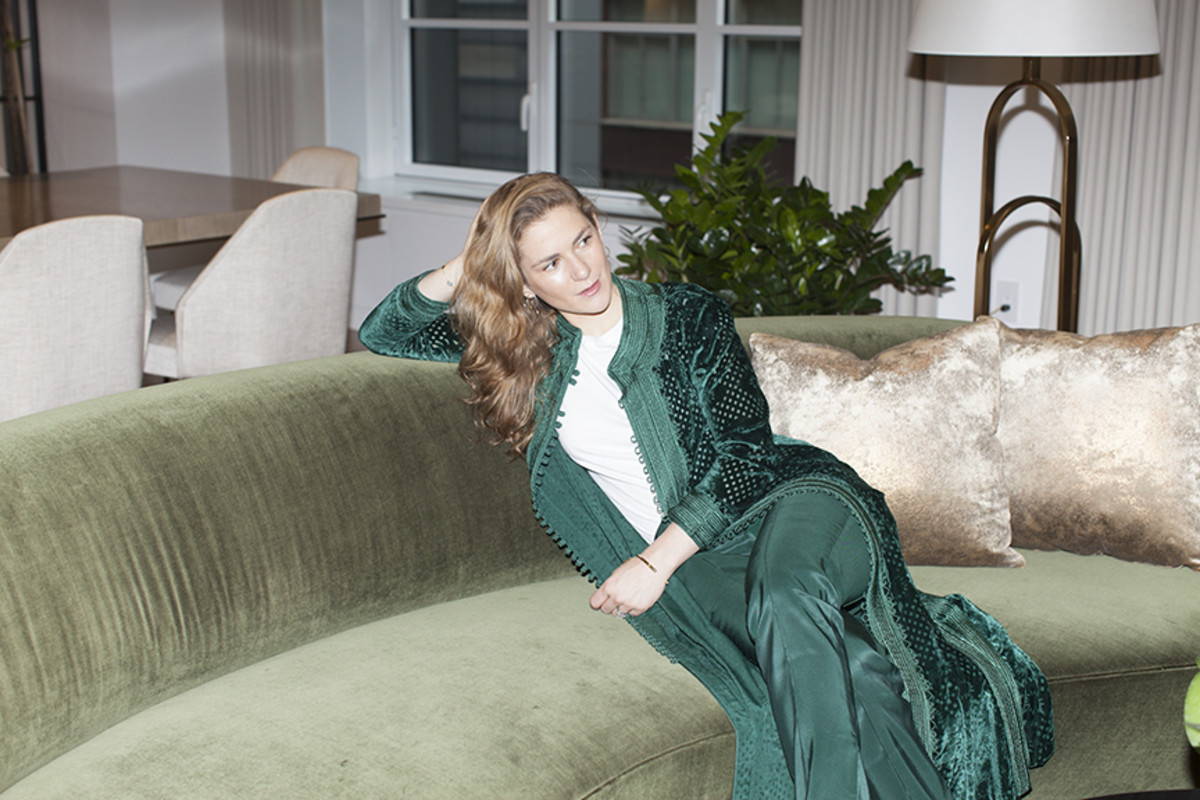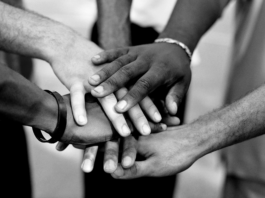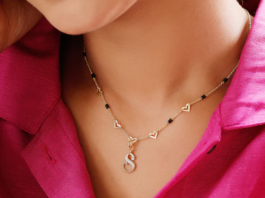

Fivestory founder Claire Distenfeld. Photo: Courtesy
The recent collapse of American retail has become so feared (and so extensively covered) that it has earned its own scary nickname: The retail apocalypse. But like most establishments on the Upper East Side — the Frick Museum, Central Park, the St. Regis — things are looking a bit more tranquil at Claire Distenfeld’s boutique Fivestory.
There, the only chaos comes in the form of recent renovations. The store is celebrating its fifth anniversary this year by expanding into the final two floors of the townhouse it has occupied since opening. One floor will be home to eveningwear and an updated shoe salon, while the other will serve as an event space dedicated to health, beauty and wellness.
“It’s five years of listening to what the customer wanted, and then saying, ‘All right, we’re going to do it,'” Distenfeld tells Fashionista in what is now the “Shoe Garden” of the boutique. (After discovering customers didn’t like to try on shoes on marble flooring, it’s set to become the new accessories center.) “I’ve always said that Fivestory actually has nothing to do with product. Fivestory is like a brand, it’s a lifestyle, it’s a way of thinking of the world — it’s a lot more than just the shoes we sell.”
It’s an approach to retail that is keeping Fivestory and its fellow concept stores alive while many others falter. We asked Distenfeld to tell us about what she’s learned over the past five years, how she discovers new brands and why she doesn’t particularly care about selling product. What retail apocalypse?
Why did you want to open a boutique on the Upper East Side?
I grew up on the Upper East Side, I went to NYU; I have been a New Yorker my whole life. I had my Upper East Side upbringing and then at 18, I like shook my parents’ hand and was like, “See ya! I hate it up here, I’m going downtown.” I was a really downtown kid — you actually wouldn’t have recognized me. I was very artsy and hipster and lived on the Lower East Side.
In college, I went to Paris for a year. I didn’t know anyone, I didn’t speak the language and for the first three weeks, it was extremely lonely. What made me feel good were these neighborhoods that felt Old World — elegant and timeless — and I started kind of putting the two and two together: I was like looking for the Upper East Side in Paris.

Inside Fivestory. Photo: Courtesy
Madison Avenue was a wasteland. I was like, “There’s so much potential up there. Nobody’s doing anything cool. Let’s go against the grain. Let’s do something that nobody’s doing.”
I also knew that Fivestory as a brand wasn’t about being cool, and is never about being cool. It’s not about trends; it’s about this timelessness, and it just seemed more coherent to do it here.
How do you choose what ends up in the store?
I’ve got a very, very, good channel of communication from my gut to my brain, so it starts there. What I did very shortly after opening Fivestory is that I surrounded myself with people who are very brain-heavy and less gut-heavy, so that they would tell me “no” most of the time, or when things were impossible. If I fight for something, it means that I think it’s really going to work; if I get exhausted and I don’t fight for something, it means that maybe my gut was a little off. So, usually, it’s really instinctual and I think I’m pretty consistent with my taste.
How do you discover new brands?
I have to say that social media is a huge thing. I’m also always taking pictures of things. I’m going through all types of weird magazines. My husband makes fun of me because I read 10 magazines in languages I’ve never heard of.

A rendering of Fivestory’s upcoming expansion. Photo: Courtesy
Why expand the boutique?
Listen, when we opened, I had never worked a day in retail in my entire life, so it’s very expected that we made a lot of mistakes — the shoe area being one. When I came up with the idea with Brian, we were like, “Shoe Garden! Sky light, fountain, it’s going to be amazing.” But nobody wants to try on shoes here, so we realized that we really needed to tweak the things that were not working and we needed to give the customer what they wanted. The customer wants special things, specialty dressing, they want eveningwear, they want an area that is maybe a little more private to try things on. The floors above, they were the bedrooms of this townhouse and there are fireplaces in each room, so they really feel warmer and cozier.
You’re also expanding into new categories, like wellness. Why?
As I’ve evolved, I’ve wanted my brand to evolve. I’ve been obsessed with health my entire life; I was a weird little girl that asked to wrap my tuna fish sandwiches in seaweed and not bread. Ask my mother, I was always a little bit off in that way. [laughs]
I’ve gotten more into health and wellness as I got older and had to take care of myself, and I wanted to incorporate it into my brand — not only because I was interested in it, but because as you build a brand, you build a relationship with your customer and I wanted to do more than just sell her product. While it feels really good to sell product to our customer and make her feel good from the outside in, it was also really important to make her feel good from the inside out.
Our top floor is this rotating experiential space. We are going to be working with vastly different brands with different motives, but there will always be this wellness and feel-good vibe up there.
How often would you say you’re here interacting with your customers?
I’m in the store probably four out of five days. I meet customers here on appointments; I style a few of our best customers, so when they ask me, I will literally drop everything to be here. Some weeks I could be here with three customers for two hours each customer and sometimes I’m just here just looking at the new product. I’m always trying things on, seeing how things fit, if they’re off, if they’re not comfortable, if they’re itchy — that’s really important to me.
How have you seen retail change over the past five years?
When I conceived Fivestory, retail was in a weird, dark place; it was right after the recession. Then the trajectory went so steep, so fast, and people got really excited and everyone started to do really well. Everyone wanted to open in New York and no one really thought about how artificial that upward curve was, so I think the space got really crowded. Department stores expanded, and when a department store expands, they’re not taking on 10 or 12 of your brands, they’re taking on all the brands. Now points of distribution are crazy, the amount of spaces that are selling the same brand.
Social media has changed everything; brands have gotten into their own direct consumer space. The competition in general has just gotten fierce, and I think for some it’s gloomy because it’s a fight — competition just means a fight of some sort. For others that have always been about the brand and not the product — which goes back to what I was saying — it’s very exciting, because I will have to work a little bit harder to have different product and to come up with our own product.

Claire Distenfeld with Fivestory’s new beret. Photo: @claire_fivestory/Instagram
We’ve been coming up with our own Fivestory line, which for me is just all about weird things that I’m obsessed with that aren’t on trend but are fun and timeless. Like every industry, you’ve always had to evolve. Our roots aren’t that deep that we can’t pivot that easily. A department store has some really deep roots, so it’s hard.
The Fivestory advantage is that we started with a very loud Instagram presence, both myself and the store. Through our mailers and through our Instagram, we’ve been able to have a voice. That started to build a really authentic relationship, because I remember in the beginning, I used to respond to every single comment; I’d respond to every single message, I’d respond to every single everything. At this point, I really can’t, but I still try to. I’m pretty approachable in that sense. We didn’t have PR forever, so if you wanted to get in touch with me, you had to email me. The direct line to the store and to myself for the last fives years has been very accessible and I think that’s why people trust our voice.
How do you balance brick and mortar with e-commerce?
E-commerce for us is actually pretty new; it’s about a year and a half old. Right now, we’re very omnichannel. Everything that we sell online, we sell in the store and vice versa. The e-commerce is blowing up, so I don’t know where it’s going to go, but we’re just taking it day by day.
What have you learned about working retail over the past five years?
I learned to not take things so seriously. I learned to not be so emotional. Retail is extremely emotional. It’s the least consistent industry in the world; especially in the store, you can have someone walk in and spend your whole week, and then you can have a day where you’re just like, “Oh my God, why am I in this industry? Oh my God, everything is falling apart.” I used to let the day to day get to me and now I’m much more big picture.
Not to sound like a broken record, but it’s not about what you sell — it’s never about what you sell. It’s about your brand, it’s about your voice, it’s about why you’re selling what you’re selling and getting the message across to your customer about why they need something or how they can wear it or why it will make them feel good. There’s a narrative that is so far removed from the tangible product that is just obvious to me, which wasn’t obvious to me when I started.
How do you choose the people who work here?
We had a revolving door in the beginning. When you start a business, you have to be very ready to let go of people that aren’t working, and I think that was hard for me because I was really young. I was 25, and to fire someone was a bizarre feeling. But you start to realize that the most important thing to put money into is not your furniture in your store and it’s not like a new cool thing on your e-commerce site, it’s the people that work for you.
I go back to the same way I pick product: It starts with the gut. You have to have people who believe in the brand. Everyone here is about the brand, they’re not about their paycheck. We obviously have a very, very great work environment here, but everyone here works their ass off, and they do it because they want to. I actually call the office sometimes at 9:00 and if there’s anyone in the office, I’m like, “Get the hell out and go home.” It’s important for me that they have a very healthy work/life balance.
I set up the office so that all the desks are in a circle and I’m obviously just in the circle like everyone else, so it’s very democratic and it’s very open ended.

The entrance of Fivestory. Photo: Courtesy
When you first started, you said you wanted something that was like a Colette in New York. How do you feel about Colette closing?
People were texting me, because when we opened, my first article that ever came out was in Vogue and it said, “Is Fivestory the New York Colette?” Colette was a huge part of why I opened this store; when I was in Paris, I would go to Colette almost every day. There was a magic there. I never wanted to be compared to it in the sense that I was trying to be them; I wanted a magic, and the magic of Colette was in Sarah, and I don’t think that’s replaceable. It was a very emotional moment. I totally understand why she’s doing it. I asked a friend of mine for her email address and I wrote her an email pouring my guts out, because I wanted her to know what she meant to all the other retailers in the world.
What is your ultimate goal for FiveStory?
I want to take the brand to the next stage of retail; I want to be the source for a lot more than just product. I want the brand to be the source for what makes you feel good. If it is a new dress, then it’s a new dress; if it is a new form of meditation, it’s a new form of meditation. If it is deciding to take all the toxic beauty out of your life, then I want you to be able to come here and learn about it.
Before I opened Fivestory, I was in the art world for six years. I was obsessed with art and with the storytelling of it; I was obsessed with the history, finding new designers, and talking about why it was important. I was the worst art dealer in the world because all I wanted to do was educate. People would come into my gallery and I’d passionately talk about the art and the paintings and then they would leave. My boss would be like, “All right, which one are they buying? They’ve been here for two hours.” I was like, “Oh, I have to sell it?” It just never made sense to me to sell it.
I want to do that with Fivestory: I want to always have a story to tell and educate and inspire. I don’t actually think, in this day and age, you are dictating what people want. You’re inspiring them to be themselves, to be the best versions of themselves, because all the customers have their own style and their own point of view. I think if we can do that in broader categories than product, then we’ve succeeded.
This interview has been edited and condensed for clarity.
Want the latest fashion industry news first? Sign up for our daily newsletter.












